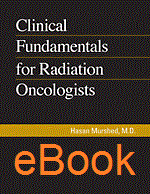
Clinical Fundamentals for Radiation Oncologists
Author: Hasan Murshed, MDISBN: 9781930524705
Published: 2011 | 680 pp | eBook
Price: $ 70.00
The Royal Australian and New Zealand College of Radiologists Website | May 2012
Clinical Fundamentals for Radiation Oncologists by Hasan Murshed aims to be a ‘succinct but informative handbook’ for radiation oncologists in training or currently practising. It follows on from Murshed’s first publication Clinical Fundamentals for Radiation Oncology Residents and is intended to serve as a practical guide for the management of cancer patients.
Murshed initially wrote this handbook with residents in mind, and has since updated it to make it useful to radiation oncologists, presumably those in the first stages of their career. The overall appearance and layout of the book is certainly in keeping with this, resembling in some regards the Oxford Handbook of Medicine, which I remember well as being my lifeline in my first year on the wards as an intern.
The book is divided into three main sections: Part 1 Basic Science of Radiation Oncology, Part 2 Clinical Radiation Oncology and Part 3 Palliative Care and Complications. Part 1 gives an overview of radiation physics and radiobiology and also includes sections on radiation protection, and the specific statistical considerations required for clinical radiation oncology trials. Part 2 outlines the clinical management of cancers based on histological type ranging from skin cancers through to paediatric cancers. Each cancer is considered with regard to required work up, staging, treatment, radiotherapy technique, outcomes, and treatment toxicity and follow up. Finally, Part 3 addresses management of oncological emergencies and details organ specific acute and late radiation toxicities with suggestions for management.
The book is A4 sized and designed to be brought to clinic for quick reference, with an easy-to-read contents section making finding the required information simple and fast. The background information in Part 1 is not enough for clinicians to develop a complete understanding of the issues, but is certainly a good place to start for a trainee, and a good reference or reminder for practitioners. In Part 2, a comprehensive list of cancer subtypes is addressed.
The information is presented in clear bullet point form where possible and appears to cover the main issues for each type of cancer. What is different from other similar books is the more modern approach to the radiotherapy planning sections— traditionally the most confusing aspect of management for most trainees and newly qualified radiation oncologists. In many cases, the text clearly outlines the simulation process and indicates appropriate ways to mark treatment volumes such as GTV and CTV. Where it is relevant, bony landmarks for treatment planning are also included with DRR images illustrating the standard treatment fields e.g. pelvic radiotherapy. It also includes specific reference to the use of IMRT for specific cancers, where it is indicated and how to do it. Where available, QUANTEC toxicity data has been included.
The text is augmented by clear diagrams, tables and screenshots of plans to illustrate the points made. In addition to this, there is also an emphasis on the use of evidence-based medicine. To justify and explain the various management options and treatment techniques, Murshed has not only given references, but has included annotated bibliographies throughout, with a paragraph or so on each seminal paper outlining the pertinent and clinically relevant findings. I found this particularly useful as it gives trainees an indication of reasons why various treatment options are suggested as well as encouraging them to see evidence-based medicine as an integral part of everyday clinical practice. Part 3 is also a useful section, emphasising the clinical management of emergencies and toxicities. It is very practical and clearly is supposed to be used in the emergency room or treatment review clinic as a quick reference to aid the clinician.
I think I would have found this book very useful myself throughout my registrar years, and expect I would have used it frequently during clinic and ward consults. Oncologists working in a more general environment will also benefit, but it’s less likely to be of significant use for those a few years into specialist practice. This book is clearly most useful for those in training or those just about to embark on their radiation oncology career and I certainly will recommend it to my colleagues in this situation.
Vanessa Estall is a radiation oncologist currently working at Peter MacCallum Cancer Centre in Victoria. She has a special interest in Central Nervous System, Skin and the implementation of new radiotherapy technologies into clinical practice.


